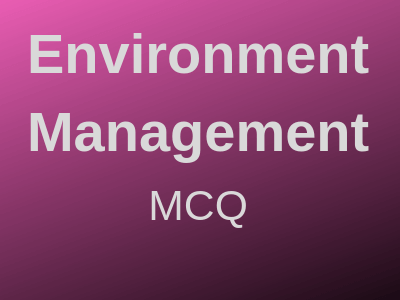1. What is an industrial symbiosis
A. When industries co-operate so that a product produced by one of them is part of a larger product produced by the other.
B. When industries co-operate by integrating environmental work so that a common environmental management system is established.
C. When industries co-operate so that the waste of one serve as input in the production of the others as for example heat.
Ans: C
2. Which of the certification systems EMAS or ISO 14001 is the most challenging for a company
A. EMAS
B. ISO 14001
C. They are in principle the same
Ans: A
3. FSC means:
A. Federal System of Certification is the dominant environmental certification system in the US
B. Forest Stewardship Council, a certification system for the forest industry
C. Falcon Swan Certification, a combined label of environmental excellency verified by the Nordic Council and the Swedish Society for Nature Conservation
Ans: B
4. A functional unit is
A. The average amount of exergy (in Joule) that is needed to produce a product or service that satisfy a special function
B. The average amount of material input that is needed to produce a product or service that satisfy a special function
C. The function that a product or service is intended to satisfy
Ans: C
5. System boundaries are:
A. Circumstances that are included or excluded from life cycle analysis studies
B. Processes which are included in an Environmental management system and others that are excluded
C. The ecological footprint of a product or service in relation to circumstances to be excluded
Ans: A
6. A performance indicator is:
A. The added impact of many different processes that make the complete product
B. A number describing the relationship of one phenomenon in relation to another
C. The material flow generated to produce a functional unit or service
Ans: B
7. What is integrated management systems
A. When for example environmental certification is done together with quality certification.
B. Environmental management systems that include both Life-cycle analysis and MIPS for a special product.
C. Management systems that are applicable for all functions and services regardless of the size of production units.
Ans: A
8. A waste audit means that:
A. The amount of waste (or inefficiency) that is created in the production process is checked.
B. An assessment of how much solid waste a product will generate is performed.
C. An assessment of how much unnecessary waste a product will generate when its lifecycle is to be completed is estimated.
Ans: A
9. What kind of eco-label is EMAS
A. Type I
B. Type II
C. Type III
Ans: C
10. EEA means
A. European Energy Association
B. Environmental Efficiency Audit
C. European Environmental Agency
Ans: C
11. Where was the 2002 World Summit on Sustainable Development held
A. Dublin
B. Doha
C. Johannesburg
D. Rio de Janeiro
Ans: C
12. What are the chemicals that damage the ozone layer
A. PCBs
B. DDT
C. CITES
D. CFCs
Ans: D
13. What is the average fine for an environmental prosecution
A. £8,000
B. £6,000
C. £4,000
D. £2,000
Ans: B
14. Which pollution issue is people (in the UK) most concerned about
A. Disposal of hazardous waste
B. Pollution in rivers
C. Condition of bathing water
D. Traffic fumes
Ans: A
15. The loss of rainforest each year is equivalent to the size of which country
A. New Zealand
B. Luxembourg
C. Australia
D. Pakistan
Ans: A
ENVIRONMENT MANAGEMENT Objective Type Questions pdf free Download::
16. Which of these energy sources is renewable
A. Wind
B. Nuclear
C. Coal
D. Oil
Ans: A
17. What is the legal principle for handling waste
A. Waste Hierarchy
B. Precautionary Principle
C. Duty of Care
D. Reasonably Practicable
Ans: C
18. How many companies worldwide have certified environmental management systems
A. 100,000 – Million
B. 10,000 – 100,000
C. 1,000 – 10,000
D. <1000
Ans: B
19. What is most land used for
A. Buildings
B. Roads
C. Agriculture
D. Leisure
Ans: C
20. What is the main reason for the increase in water contamination incidents
A. Increased flooding
B. Management failure
C. More chemicals
D. Operator mistakes
Ans: B
22. How much more does waste cost compared to disposal costs alone
A. 25X
B. 12.5X
C. 5X
D. 2X
Ans: B

